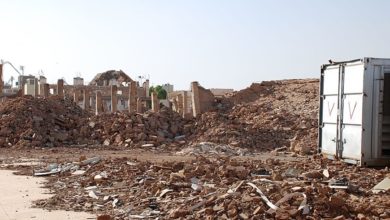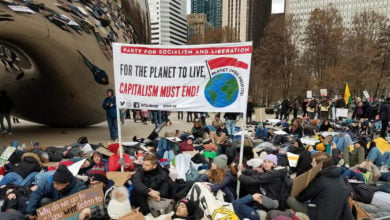Many were shocked the U.S. government did absolutely nothing to assist in the evacuation of those without the means to leave the city. No buses, planes, cars, vans or boats were pressed into service to move hundreds of thousands of people out of danger. Instead, those who could not leave, invariably the poorest residents of the city, a majority of them Black, were left to die.
With no food or water, many of those left behind were forced to search through abandoned stores looking for supplies. The government, which had done nothing to evacuate these people to safety, wasted no time in deploying heavily armed military forces and Blackwater mercenaries to “keep the peace.” Instead of being tasked with humanitarian relief, they were ordered to “shoot to kill” the so called “looters” who were struggling to survive.
Additionally, local police and white vigilante groups joined in this criminalizing of New Orleans’ poor Black residents. In the small city of Gretna near New Orleans, local police actually shot at individuals trying to leave flooded areas for Gretna’s higher ground.
Despite having known since 1995 that the levees were inadequate, the Federal government had done next to nothing to increase flood protection in New Orleans. In fact, the Army Corps of engineers had been open about the fact that after the start of the Iraq war and Bush tax cuts, money for this project disappeared.
New Orleans rebuilds, but not for the poorest workers
Four years later, the rebuilding of New Orleans and the Gulf Coast area has proceeded unevenly. There has been no major government effort, but rather a hodge-podge of government programs, private developers, non-profits and some local organizations rooted in working-class communities involved in the rebuilding effort.
Most of the media has pointed to evidence of “green shoots” in New Orleans, hopeful signs that the city is “back to normal.” Leaving aside the fact that pre-Katrina New Orleans was one of the most poverty-ridden cities in North America, this is still a very incomplete picture.
It is claimed roughly 75 percent of the individuals who left have returned. Routinely, the number of people receiving mail at an address is used to measure progress in returned citizens. Over 154,000 residents are receiving mail. That is up from 146,000 in 2008.
These numbers are misleading. Many people who are slowly rebuilding their homes are receiving mail at addresses where they have not returned to live. One Associated Press article estimated that 36 percent of housing in New Orleans is still vacant.
In the Lower Ninth Ward of New Orleans, one of the area’s hardest hit by Hurricane Katrina and a Black working-class neighborhood, only 20 percent of the pre-Katrina residents have returned, almost all of these in houses built by movie star Brad Pitt.
The city of New Orleans has embraced “inclusionary zoning,” whereby public housing is demolished and condos and apartments and middle-class housing replace them. Generally, some token percentage of units is reserved for the previous residents. Most former residents are consigned to low-quality housing elsewhere. This has been the primary mechanism of “gentrification” in housing all over the country. And New Orleans is no different. The city has demolished a number of housing projects, and left almost 250,000 sitting uninhabitable.
In terms of health care, only 27 of the 39 pre-Katrina hospitals have been reopened. As Marian Wright Edelman pointed out in a recent article, Louisiana ranked 50th in a state-by-state study of access to quality health care.
Many have pointed to the fact that New Orleans has both unemployment and foreclosure rates lower then the national average as positive signs. But many of those who have moved to New Orleans recently are not pre-Katrina residents. The city has seen an influx of college-educated individuals brought in to work as engineers, project managers and so on. In addition, certain federal laws have made it easier for people to avoid foreclosure. The combination of a city with far fewer working poor residents and new residents with more money has been crucial to presenting an image of a steadily rebuilding New Orleans.
Just as escaping the devastation of Hurricane Katrina was skewed towards those with the means to leave, and businesses were valued over the lives of starving, dehydrated people left to die, the so-called recovery has been skewed towards those with the most resources, leaving New Orleans wealthier and whiter than before.
What can prevent more Katrinas?
The most sobering fact, however, is this disaster did not have to happen at all. The levees should have been reinforced with no expense spared. Every means of transportation should have been used to evacuate residents of the Gulf Coast. Thoseleft behind should have received every assistance possible in finding food, water and shelter. Under the current social conditions, this kind of thinking was not translated into action.
For that to happen, we would need a different type of government; one where the needs of the masses of working people was the ultimate bases for decisions. The deciscion makers need not be the capitalist politicians and their corporate backers. In light of the trillions of dollars thrown away in bank bailouts and murderous wars, the original and continued suffering in New Orleans is criminal.
Under a socialist government the mountains of wealth in this country could be wielded by working people. Billions of dollars in resources could be directed into rebuilding New Orleans, and could have prevented much of the death and at least some of the destruction. Now as much as ever, the continued devastation of New Orleans makes the need for a socialist alternative strikingly clear.
Those interested in progressive efforts to help rebuild New Orleans should contact Common Ground Relief: http://www.commondgroundrelief.org/






